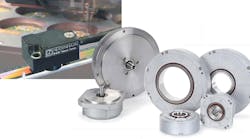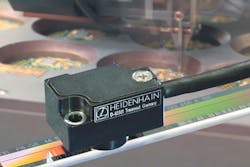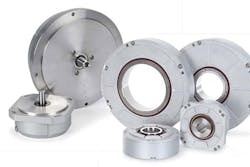This is the first of a two-part series. Part 2 can be found here.
Encoders play an integral role in almost every mechanical system that involves motion monitoring or control. There are a variety of types that work with different kinds of motion with different options for how they detect and communicate. These are some of the foundational elements and variables in the world of encoders.
What Does an Encoder Do?
When it comes to motion—speed, distance and direction—feedback systems, encoders of one type or another are typically at the core of the operation. Put simply, they record movement metrics and communicate them in a way that a control system and/or person can use to adjust or monitor.
Common Encoders
Encoders are most often used to measure linear or rotational motion. Everything from how they are constructed to the signaling method can vary based on their environment, application and budget.
Linear Encoders
These measure straight-line motion. Sensor heads that attach to the moving piece of machinery run along guideways. Those sensors are linked to a scale inside of the encoder that sends digital or analog signals to the control system.
Rotary encoders measure rotational movement. They typically surround a rotating shaft, sensing and communicating changes in its movement. While they are accurate, rotary encoders are often used when speed management is the biggest concern. Traditionally, rotary encoders are classified as having accuracy above ± 10" (arcseconds). Rotary encoders are also available equipped with important functional safety capabilities.
When deciding on a rotary encoder for pairing with a motor, an engineer must consider the five key encoder properties that have the largest influence on motor performance: positioning accuracy, speed stability, audible noise, power loss and bandwidth. Read more about what to look for here.
Angle Encoders
Similar to their rotary counterpart, angle encoders measure rotation. These, however, are most often used in applications when precise measurement is required. HEIDENHAIN offers angle encoders with accuracy down to ± .04″ (arcseconds) and resolutions up to 29 bits.
The Difference Between Absolute and Incremental Output
Incremental encoders measure in relation to a starting point. Every time a system is turned on a new zero reference point is established, or a new one will need to be reestablished by the user. Markings or steps are spaced equally apart on the scale, or disc in the case of rotary encoders. The encoder generates a pulse-like signal based on each marking, which is translated to a signal.
On the other hand, absolute encoders recognize a distinct location at all times. It’s not relative to another and there’s no need for reestablishing a zero point. Instead of equally spaced marks, distinct tracks or markings transmit a unique code at each location to a serial control.
The Difference between Magnetic and Optical Encoders
How encoders recognize and process the various coding or markings is different. Magnetic encoders use the relation between static and/or dynamic magnetic fields or distinct tracks and translate those into signals. The other common design is optical, which uses light that’s passed through glass and recognized by a receiver. Magnetic assemblies are generally more simple, compact and durable, while optical encoders are extremely accurate and able to function in areas with other magnetic forces.
The Difference between Sealed and Exposed Encoders
Encoders are critical to the proper function of their mechanical system. The slightest inaccuracy or malfunction can cause a significant ripple effect on whatever the larger operation may be. Those systems and operations take place in widely different environments, from machine tools where coolant and/or metal chips may be moving around at high speeds and pressures to sterile medical labs.
Sealed and exposed encoders provide options that suit whichever type of environment in which they’ll be deployed. Sealed encoders encase the most delicate components of the encoder, protecting them from whatever contamination may be present. Exposed encoders take up less space, generally excel in high-speed scenarios and are often deployed in high-precision measuring applications.
Tom Wyatt is director of marketing and communications, HEIDENHAIN Corporation. He has more than 40 years of experience at HEIDENHAIN This article first appeared on the company’s website. For more information, click here.



